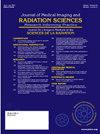Automatic segmentation of cardiac structures can change the way we evaluate dose limits for radiotherapy in the left breast
IF 1.3
Q3 RADIOLOGY, NUCLEAR MEDICINE & MEDICAL IMAGING
Journal of Medical Imaging and Radiation Sciences
Pub Date : 2024-12-30
DOI:10.1016/j.jmir.2024.101844
引用次数: 0
Abstract
Purpose
Radiotherapy is a crucial part of breast cancer treatment. Precision in dose assessment is essential to minimize side effects. Traditionally, anatomical structures are delineated manually, a time-consuming process subject to variability. automatic segmentation, including methods based on multiple atlases and deep learning, offers a promising alternative. For the radiotherapy treatment of the left breast, the RTOG 1005 protocol highlights the importance of cardiac delineation and the need to minimize cardiac exposure to radiation. Our study aims to evaluate dose distribution in auto-segmented substructures and establish models to correlate them with dose in the cardiac area.
Methods and materials
Anatomical structures were auto-segmented using TotalSegmentator and Limbus AI. The relationship between the volume of the cardiac area and of organs at risk was assessed using log-linear regressions.
Results
The mean dose distribution was considerable for LAD (left anterior descending coronary artery), heart, and left ventricle. The volumetric distribution of organs at risk is evaluated for specific RTOG 1005 isodoses. We highlight the greater variability in the absolute volumetric evaluation. Log-linear regression models are presented to estimate dose constraint parameters. We highlight a greater number of highly correlated comparisons for absolute dose-volume assessment.
Conclusions
Dose-volume assessment protocols in patients with left breast cancer often neglect cardiac substructures. However, automatic tools can overcome these technical difficulties. In this study, we correlated the dose in the cardiac area with the doses in specific substructures and suggested limits for planning evaluation. Our data also indicates that statistical models could be applied in the assessment of those substructures where an automatic segmentation tool is not available. Our data also shows a benefit in reporting absolute dose-volume thresholds for future cause-effect assessments.
心脏结构的自动分割可以改变我们评估左乳房放射治疗剂量限制的方式。
目的:放疗是乳腺癌治疗的重要组成部分。精确的剂量评估对于减少副作用至关重要。传统上,解剖结构是手工描绘的,这是一个耗时的过程,受可变性的影响。自动分割,包括基于多个地图集和深度学习的方法,提供了一个很有前途的选择。对于左乳房的放射治疗,RTOG 1005方案强调了心脏划定的重要性以及将心脏暴露于辐射的必要性。我们的研究旨在评估自分割亚结构中的剂量分布,并建立与心脏区域剂量相关的模型。方法和材料:采用TotalSegmentator和Limbus AI对解剖结构进行自动分割。使用对数线性回归评估心脏面积和危险器官的体积之间的关系。结果:LAD(左冠状动脉前降支)、心脏和左心室的平均剂量分布相当可观。根据特定RTOG 1005等剂量评估危险器官的体积分布。我们强调了绝对体积评估中更大的可变性。提出了对数线性回归模型来估计剂量约束参数。我们强调了绝对剂量-体积评估中大量高度相关的比较。结论:左乳腺癌患者的剂量-体积评估方案经常忽视心脏亚结构。然而,自动化工具可以克服这些技术上的困难。在这项研究中,我们将心脏区域的剂量与特定亚结构的剂量联系起来,并提出了规划评估的限制。我们的数据还表明,统计模型可以应用于评估那些子结构,其中自动分割工具是不可用的。我们的数据还显示,报告绝对剂量-体积阈值对未来的因果评估有好处。
本文章由计算机程序翻译,如有差异,请以英文原文为准。
求助全文
约1分钟内获得全文
求助全文
来源期刊

Journal of Medical Imaging and Radiation Sciences
RADIOLOGY, NUCLEAR MEDICINE & MEDICAL IMAGING-
CiteScore
2.30
自引率
11.10%
发文量
231
审稿时长
53 days
期刊介绍:
Journal of Medical Imaging and Radiation Sciences is the official peer-reviewed journal of the Canadian Association of Medical Radiation Technologists. This journal is published four times a year and is circulated to approximately 11,000 medical radiation technologists, libraries and radiology departments throughout Canada, the United States and overseas. The Journal publishes articles on recent research, new technology and techniques, professional practices, technologists viewpoints as well as relevant book reviews.
 求助内容:
求助内容: 应助结果提醒方式:
应助结果提醒方式:


